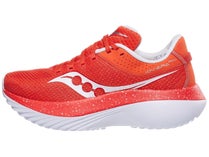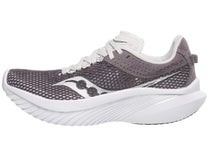Saucony Kinvara 12 Review
Saucony's High-Value Trainer Flaunts its Versatility
Likes
- Lightweight versatility
- Sleek and comfortable upper
- Simple high-value design
Dislikes
- Does not shine in any particular category
- Not as responsive as other Saucony shoes
What's New
Saucony has updated the Kinvara 12 from top to bottom, outfitting it with a new blended PWRRUN topsole and midsole, a strategic rubber outsole layout, and last but not least, a more streamlined engineered mesh upper design. Although the shoe features some significant changes, this lightweight daily trainer remains true to its origins and will continue to be a great option for faster daily runs on the roads.
The Bottom Line
The Saucony Kinvara is a lightweight daily trainer that has been praised over the years for its versatility, and version 12 is set to continue that tradition with the help of a multitude of updates. Unfortunately, with the success of the Endorphin line, the Kinvara faces some serious competition from its Saucony siblings. The PWRRUN midsole and PWRRUN+ topsole work well together to offer runners a balanced underfoot experience that can smoothly push the pace when desired, but again, compared to other Saucony shoes featuring a PWRRUN PB midsole, the Kinvara 12 lacks a bit of energy return. The updated engineered mesh upper remains lightweight and provides a snug, locked-in fit. Although it may be too form-fitting for some, the Kinvara 12 should be able to accommodate most runners comfortably. Finally, what truly sets the Kinvara apart is its approachable price tag, and at $179, this shoe is a high-value buy that will satisfy the majority of runners' daily training needs.
Shoe Performance
Softness i
Ride/Energy Return i
Underfoot Protection i
Flexibility i
Upper Support i
Specifications & Fit
How It Fits
| Toe Box | Width: Medium to narrow | |
| Midfoot Volume | Medium | |
| Heel Width | Medium to narrow | |
| Arch Height | Medium |
Shoe Specs
| Weight | Men's: 7.5 oz (size 9) | Women's: 6.3 oz (size 8) | |
| Stack Height | 28 mm (Heel), 24 mm (Forefoot) | |
| Terrain | Road | |
| Stability | Neutral | |
| Sizing | True to Size |
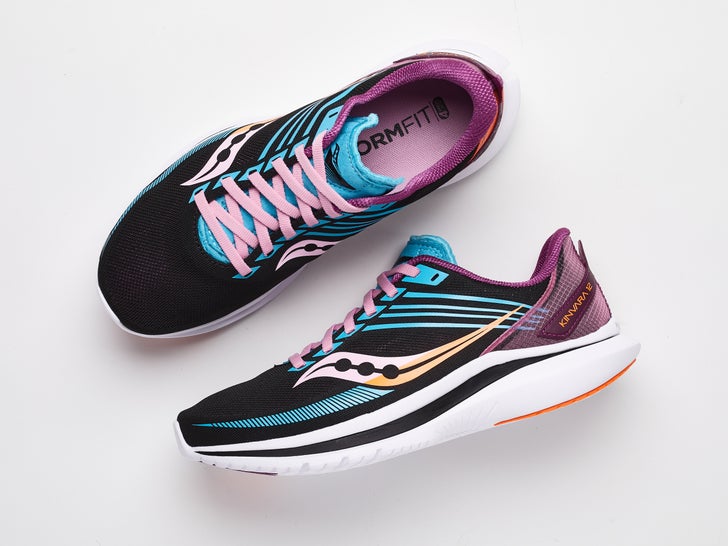
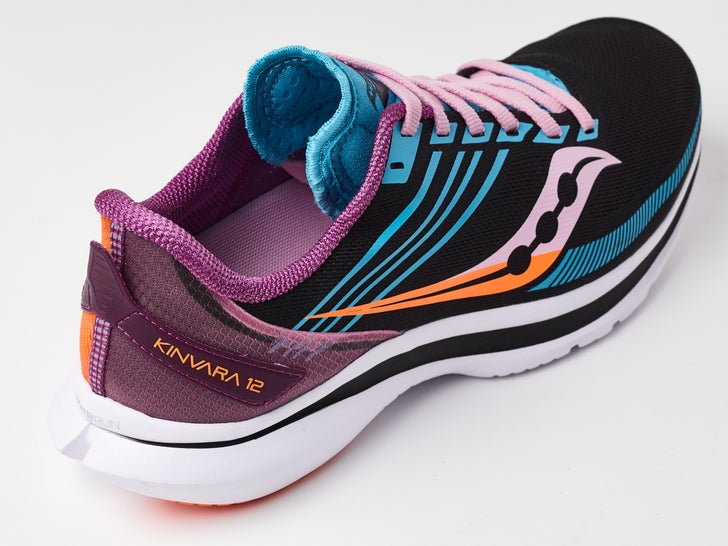

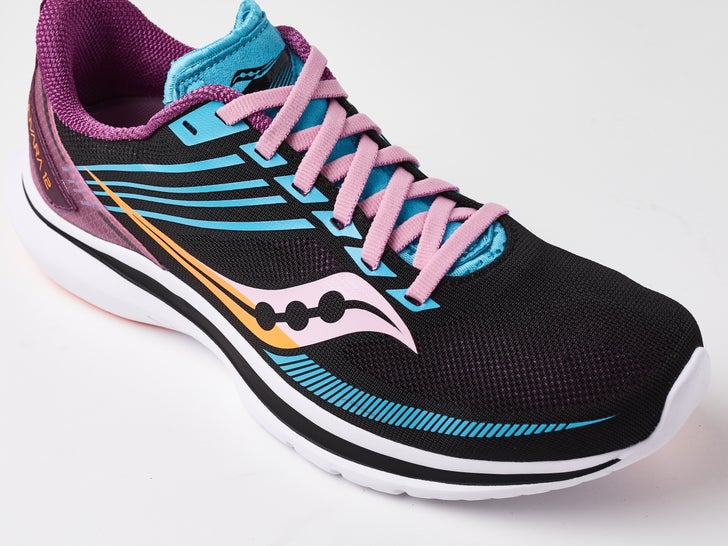








Our In-Depth Look
Shoe Softness i
Justin: "The Kinvara 12 feels a little comfier than the 11, but it also feels lower to the ground. This low-to-the-ground feeling could be from the new flex grooves, but I am not certain. However, despite a slightly softer step-in feel, I felt as though the 12 wasn't as protective on the run as its predecessors."
Connor: "The Kinvara 12 continues to be fairly balanced underfoot with a slightly firmer ride. It seems Kinvaras have gotten firmer over the years, and the 12 even feels just a hint firmer than the 11. That being said, I didn't find the ride uncomfortable and felt it could still handle a wide range of paces fairly well."

Ride/Energy Return i
Justin: "The Kinvara has solid energy return. It isn't a bouncy feel, but rather, firm responsiveness. The Kinvara 12 feels like a good alternative to some of the other shoes that are currently in my rotation."
Connor: "The Kinvara continues to offer a hint of pop that has no problem picking up the pace, but when compared to some of the new PWRRUN PB shoes, it's not in the same ballpark. For the price, this shoe continues to be a fantastic option that both loyalists and fans of simple, lightweight trainers will love."

Underfoot Protection i
Justin: "The Kinvara 12 feels lower to the ground than the previous model. For some, this may limit the level of versatility of this update compared to its predecessors. I felt like the cushion was enough for me to do longer runs in, but I wouldn't take the Kinvara farther than half-marathon distances."
Connor: "The Kinvara continues to provide a low, connected-to-the-ground feel (v12 is even just a hint lower than v11) and has just enough protection for daily training. While I personally prefer a little more stack for my daily training runs, I found the Kinvara to be fairly versatile and wore it for a range of distances and paces."

Underfoot Flexibility i
Justin: "The Kinvara 12 flexes well through the forefoot. The heel can feel a little stiff, but it makes up for that with a smooth forefoot transition."
Connor: "This shoe continues to offer a decent flex that feels natural on foot. The low-to-the-ground design, mixed with a low drop and flexibility, helps to create a familiar Kinvara feel year after year."

Upper Feel i
Justin: "I wasn't a huge fan of the upper in the Kinvara 12. It felt like it was a bit tighter than the previous model. That tightness didn't cause any significant issues, but I didn't really like the feel. Also, the materials seemed to be a little less 'premium' than the previous year."
Connor: "This shoe's upper is fairly minimal and helps keep weight down. It has just enough cushion to get me through some longer distances, but similar to past models, there's not much to it. It's thin, breathable, and somewhat snug-fitting."

Individual Thoughts

The Kinvara 12 feels like a return to the original intent of the shoe (a lightweight, more natural feeling trainer). In my opinion, this is not the best thing. Version 12 feels slightly less protective than previous models, thus leading me to use the shoe less often than I normally would. That said, I still found myself enjoying the kilometres in the Kinvara 12. My biggest dislike was the upper, which was noticeably tighter than the previous versions. I didn't experience any blistering or hotspots, and there weren't any "deal breakers," it just wasn't my favourite upper.
Softness
FirmSoftRide/Energy Return
Less SpringyMore SpringyUnderfoot Protection
LowHighFlexibility
RigidElasticUpper Support
StructuredAdaptable
The Kinvara once again carries on its legacy as a lightweight performance trainer, and while it may not be as exciting as when it was first released 13 years ago, the Kinvara remains a fun running shoe that has the versatility to handle a wide variety of training runs. More responsive midsole materials have been released in other Saucony shoes, but it is hard to beat the level of performance that the Kinvara delivers with a $179 price point.













